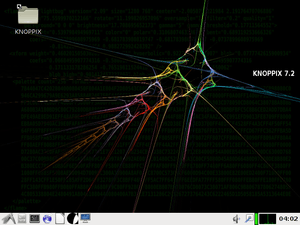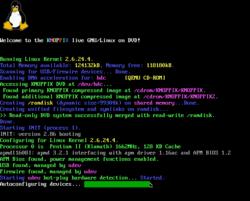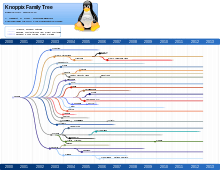Knoppix
 | |
 KNOPPIX 7.2 with LXDE | |
| Developer | Klaus Knopper |
|---|---|
| OS family | Unix-like |
| Working state | Current |
| Source model | Open source |
| Initial release | September 30, 2000 |
| Latest release | 8.2 / May 14, 2018 |
| Available in | German and English |
| Update method | APT (front-ends available) |
| Package manager | dpkg |
| Kernel type | Monolithic (Linux) |
| Userland | GNU |
| Default user interface | LXDE (previously KDE) |
| License |
Free software licenses (mainly GPL)[1] |
| Official website |
www |
KNOPPIX (/ˈknɒpɪks/ KNOP-iks)[2] is an operating system based on Debian designed to be run directly from a CD / DVD (Live CD) or a USB flash drive (Live USB), one of the first of its kind for any operating system. Knoppix was developed by, and named after, Linux consultant Klaus Knopper. When starting a program, it is loaded from the removable medium and decompressed into a RAM drive. The decompression is transparent and on-the-fly.
Although KNOPPIX is primarily designed to be used as a Live CD, it can also be installed on a hard disk like a typical operating system. Computers that support booting from USB devices can load KNOPPIX from a live USB flash drive or memory card.
There are two main editions: the traditional compact-disc (700 megabytes) edition and the DVD (4.7 gigabytes) "Maxi" edition. Each main edition has two language-specific editions: English and German.
KNOPPIX mostly consists of free and open source software, but also includes some proprietary software, as long as it fulfils certain conditions.[3]
Knoppix can be used to copy files easily from hard drives with inaccessible operating systems. To quickly and more safely use Linux software, the Live CD can be used instead of installing another OS.
Contents

More than 1000 software packages are included on the CD edition and more than 2600 are included on the DVD edition. Up to nine gigabytes can be stored on the DVD in compressed form. These packages include:
- LXDE, a lightweight X11 desktop environment (default for 6.0.1 and later), or KDE 3, a more feature-complete desktop which is the default for 5.3.1 and earlier releases.
- MPlayer, with MP3 audio, and Ogg Vorbis audio playback support
- Internet access software, including the KPPP dialer and ISDN utilities
- The Iceweasel web browser (based on Mozilla Firefox)
- The Icedove e-mail client (based on Mozilla Thunderbird)
- GIMP, an image manipulation program
- Tools for data rescue and system repair
- Network analysis and administration tools
- LibreOffice, a comprehensive office suite
- Terminal server
Hardware requirements
Minimum hardware requirements for Knoppix:[4]
- Intel/AMD-compatible processor (i486 or later)
- 32 MB of RAM for text mode, at least 128 MB for graphics mode with LXDE (at least 512 MB of RAM is recommended to use the various office products)
- Bootable CD-ROM drive, or a boot floppy and standard CD-ROM (IDE/ATAPI or SCSI)
- Standard SVGA-compatible graphics card
- Serial or PS/2 standard mouse or IMPS/2-compatible USB-mouse
Saving changes in the environment
Prior to Knoppix 3.8.2, any documents or settings a user created would disappear upon reboot. This lack of persistence then made it necessary to save documents directly to a hard drive partition, over the network, or to some removable media, such as a USB flash drive.
It was also possible to set up a "persistent home directory", where any documents or settings written to the user's home directory would automatically be redirected to a hard drive or removable media, which could be automatically mounted on bootup. A single file, knoppix.img, was cached on the rewritable media and used to simulate a file system into which files were written for later use. This allowed the user to transparently write to their home directory.
Union mount support was added in version 3.8.1 through UnionFS. This was later replaced by Aufs in 5.1.0 to improve stability.[5] The union mount allowed virtual updates to the data on the read-only CD/DVD media by storing changes on separate writable media and then representing the combination of the two as single storage device. The writable media could be memory (ramdisk), a hard disk, USB flash drive, etc. This means that the user could modify the software installed on the Knoppix system, such as by using APT to install or update software. The storage device containing the changes needed to be present whenever Knoppix is started, else only the original data from the disc would be used. While Knoppix would scan available storage devices for a persistent home directory by default, a user could dictate a specific location with a boot option (see below) such as:
home=/dev/hda1/knoppix.img[6]
By carrying a Knoppix CD and a USB flash drive, a user could have the same environment, programs, settings, and data available on any computer that could run Knoppix.
This functionality was only available through Knoppix 5.1.1 (CD release) or 5.3.1 (DVD release). Subsequently, the Live CD paradigm has transformed into portable operating systems that run on external storage.
Boot options
When using Knoppix as a Live CD, one can use boot options, also known as 'cheatcodes', to override a default setting or automatic hardware detection when it fails. For example, the user may wish to boot into a plain console, or proceed without SCSI support. For this, Knoppix allows the user to enter one or more cheat codes at the prompt before booting. If the user does not enter a cheat code, or does not press any key before the timeout, Knoppix will boot with its default options. For example, to set the language to French rather than the default, one would type:
knoppix lang=fr[6]
Knoppix is a 32-bit Debian Linux based distro, but recent releases (including the latest version 7.6) have also been equipped with a 64-bit kernel on the DVD edition, where it will automatically boot up for 64-bit computers, or by using the boot option knoppix64 manually in the command-line prompt, while knoppix will boot up the 32-bit kernel. Neither PAE nor 64-bit applications are supported by Knoppix, and system memory with more than 4 GB can only be used with a 64-bit kernel.
The DVD edition of Knoppix can also be loaded onto a USB flash drive, with flash-knoppix under the Knoppix system, such that "the KNOPPIX Live System starts and runs about factor 5 faster from USB flash disk than from CD or DVD!".[7] Besides that, the experimental UEFI support is provided for USB flash drive rather than DVD media. 32-bit UEFI firmware can only boot up the 32-bit kernel, while 64-bit UEFI firmware can only boot up the 64-bit kernel. The text interface for UEFI is similar with it for BIOS, one can also press key F2 and F3 to access information on boot options.
Popularity
Knoppix was one of the first Live CD Linux distributions to gain popularity.[8] There are several factors that contribute to the popularity of Knoppix:
- Knoppix was one of the first Live CDs available, and is known as the "original" Debian-based Live CD
- Its extensive hardware detection allows most systems to start Knoppix without any configuration
- Its ability to automatically connect to most kinds of networks
- Its utilities for system repair and troubleshooting
Knoppix works on a fairly large number of PCs or laptops, but not all. The automatic hardware detection cannot cope with all hardware, and sometimes the drivers used will not be optimal. Knoppix has difficulty recognizing some cards made before 1998, or motherboards with a BIOS made before 2002. (In some cases, manual configuration with codes entered at boot time can overcome problems with automatic detection.)
If a PC does not have enough RAM to run KDE and other included programs, the legacy Knoppix (earlier than 6.0) boots up a very limited twm session instead. The only window running in the twm session by default is xterm.
Versions
| Knoppix version | Release date | CD | DVD |
|---|---|---|---|
| 1.4 | 2000-09-30 | Yes | No |
| 1.6 | 2001-04-26 | Yes | No |
| 2.1 | 2002-03-14 | Yes | No |
| 2.2 | 2002-05-14 | Yes | No |
| 3.1 | 2002-10-01 | Yes | No |
| 3.2 | 2003-06-16 | Yes | No |
| 3.3 | 2003-09-22 | Yes | No |
| 3.4 | 2004-05-17 | Yes | No |
| 3.5 LinuxTag-Version | 2004-06 | No | Yes |
| 3.6 | 2004-08-16 | Yes | No |
| 3.7 | 2004-12-09 | Yes | No |
| 3.8 CeBIT-Version | 2005-02-28 | Yes | No |
| 3.8.1 | 2005-04-08 | Yes | No |
| 3.8.2[9] | 2005-05-12 | Yes | No |
| 3.9 | 2005-06-01 | Yes | No |
| 4.0 LinuxTag-Version | 2005-06-22 | No | Yes |
| 4.0 updated | 2005-08-16 | No | Yes |
| 4.0.2 | 2005-09-23 | Yes | Yes |
| 5.0 CeBIT-Version | 2006-02-25 | No | Yes |
| 5.0.1 | 2006-06-02 | Yes | Yes |
| 5.1.0 | 2006-12-30 | Yes | Yes |
| 5.1.1 | 2007-01-04 | Yes | Yes |
| 5.2 CeBIT-Version | 2007-03 | No | Yes |
| 5.3 CeBIT-Version | 2008-02-12 | No | Yes |
| 5.3.1 | 2008-03-26 | No | Yes |
| ADRIANE | |||
| 6.0.0 | 2009-01-28 | Yes | No |
| 6.0.1 | 2009-02-08 | Yes | No |
| 6.1 CeBIT-Version | 2009-02-25 | Yes | Yes |
| 6.2 / ADRIANE 1.2 | 2009-11-18 | Yes | Yes |
| 6.2.1 | 2010-01-31 | Yes | Yes |
| 6.3 CeBIT-Version | 2010-03-02 | No | Yes |
| 6.4.3 | 2010-12-20 | Yes | Yes |
| 6.4.4 | 2011-02-01 | Yes | Yes |
| 6.5 CeBIT-Version | 2011-03 | No | Yes |
| 6.7.0 | 2011-08-03 | Yes | Yes |
| 6.7.1 | 2011-09-16 | Yes | Yes |
| 7.0.1 | 2012-05-24 | No | Yes |
| 7.0.2 | 2012-05-30 | No | Yes |
| 7.0.3 | 2012-07-01 | Yes | Yes |
| 7.0.4 | 2012-08-20 | Yes | Yes |
| 7.0.5 | 2012-12-21 | Yes | Yes |
| 7.2.0 | 2013-06-24 | Yes | Yes |
| 7.4.0 | 2014-08-07 | No | Yes |
| 7.4.1 | 2014-09-15 | No | Yes |
| 7.4.2 | 2014-09-28 | No | Yes |
| 7.5 CeBIT-Version | 2015-03-16 | No | Yes |
| 7.6.0 | 2015-11-21 | No | Yes |
| 7.6.1 | 2016-01-16 | No | Yes |
| 7.7.0 CeBIT-Version | 2016-03-14 | No | Yes |
| 7.7.1 | 2016-10-27 | No | Yes |
| 8.0.0 CeBIT-Version | 2017-03-24 | No | No |
| 8.1.0 | 2017-09-27 | No | Yes |
| 8.2.0 | 2018-05-14 | No | Yes |
As of April 2008, from version 4 up until 5.1.1, Knoppix has been split into a DVD "maxi" edition (with over 9 GB of software), and a CD "light" edition, both developed in parallel.[10][11]
The table (to the right) shows the version history of major releases.
The KNOPPIX 6.0.1 / ADRIANE 1.1 is a CD-edition again, and a complete rebuild from scratch. LXDE as default desktop and a very reduced software collection in order to easily fit on CD.[12] No further development is being done of the traditional 5.x versions.
The KNOPPIX 6.2.1 release has both CD and DVD editions, and the ADRIANE 1.2 only has a CD-edition.[13]
The KNOPPIX 8.0.0 edition was released at CeBIT 2017.[14] The KNOPPIX 8.1.0 was released in September 2017 as a first public release in KNOPPIX 8.x series.[15] The version 8.0.0 has the dual boot, and a choice between three different desktops:LXDE as default option, KDE or GNOME[14].
Derivatives
Adriane Knoppix
Adriane Knoppix is a variation that is intended for blind and visually impaired people, which can be used entirely without vision oriented output devices. It was released in the third quarter of 2007 as a Live CD. Adriane Knoppix is named after Adriane Knopper, the wife of Klaus Knopper, the developer of Knoppix. Adriane has a visual impairment, and has been assisting Klaus with the development of the software.[16] The name Adriane is also a backronym for "Audio Desktop Reference Implementation And Networking Environment".
Adriane Knoppix is intended not only for the blind but also for beginners who don’t know much about computers. It uses the SUSE Blinux screen reader with a phoneme generator and speech engine for normal output.
Other variations

- Damn Small Linux, a Live CD, just over 50 MB. It is designed to run graphical applications on older PC hardware - for example, machines with 486/early Pentium processors and very little memory.
- Dreamlinux, a Brazilian distribution branched off from Morphix, centers on ease of use and graphics performance.
- Kali Linux, a live CD/USB distribution now based on Debian. It is a rewrite of BackTrack, which was based on Knoppix. Like its predecessors, Kali is designed for digital forensics and penetration testing. BackTrack itself merged the Auditor Security Collection and WHAX distros.
- Kanotix, a live distribution now based on Debian.
- KnoppMyth, a distro that attempts to make the Linux and MythTV installation as trivial as possible.
- Musix GNU+Linux, specifically for musicians.
- Poseidon Linux, a widely acclaimed distribution specifically geared for the scientific community.
- Quantian, for numerical and quantitative analysis.[17]
- KnoppiXMAME, designed for playing MAME videogames
- PelicanHPC for clustering
- TechUSB an automated computer distro produced by RepairTech, Inc.
Unmaintained projects
- Sorted chronologically, in ascending order.
| Name | Goal and notes | Last version | — dates back to |
|---|---|---|---|
| ClusterKnoppix | Uses openMosix. | 3.6 | 1 September 2004[18] |
| Feather Linux | 128 MB image with Linux 2.4, works as a Live CD and Live USB. | 0.7.5 | 4 July 2005[19] |
| Auditor Security Collection | Intended to test the security of networks.[20] Merged into BackTrack by early 2007. | 200605-02 | 20 June 2005[21] |
| Kaella | The French translation of Knoppix | 3.2 | 19 September 2007 |
| Kurumin | In Brazilian Portuguese. Poseidon Linux is a later distribution that was based on Kurumin. | 8.6 | 18 June 2008[22] |
| VMKnoppix | VM tools | 5.3.1 Xen3.2.1 | 27 August 2008[23] |
| BackTrack | Parts based on a merge from Auditor Security Collection. | 5 R3 | 15 August 2012 |
See also
Notes
Books
News article
References
- ↑ "KNOPPIX Linux Live CD: What license does the KNOPPIX-CD use?". Retrieved 2007-07-16.
- ↑ Two Weughty Questions Archived 2009-01-14 at the Wayback Machine. on Debian newsgroup post
- ↑ "General FAQ". Archived from the original on 27 May 2015. Retrieved 26 May 2015.
- ↑ "KNOPPIX - Live Linux Filesystem On CD". Archived from the original on 4 May 2018. Retrieved 26 May 2015.
- ↑ "KNOPPIX 5.1 - Live Linux Filesystem On CD". Archived from the original on 11 May 2015. Retrieved 26 May 2015.
- 1 2 "Cheat Codes". Archived from the original on 27 June 2015. Retrieved 26 May 2015.
- ↑ webmaster@knopper.net. "KNOPPIX 7.6.0 / ADRIANE 1.7 - Live DVD". knopper.net. Archived from the original on 4 October 2017. Retrieved 4 May 2018.
- ↑ Borys Musielak. "polishlinux.org » Live CD". Archived from the original on 27 May 2015. Retrieved 26 May 2015.
- ↑ Introduction to Knoppix | PCMag.com
- ↑ Knopper, Klaus (2005-07-06). "KNOPPIX 4.0 in issue 8/05 with DVD of “com! Das Computer-Magazin”". KNOPPER.NET News. Knopper.Net. Archived from the original on 2005-07-08. Retrieved 2009-06-10.
- ↑ "Knoppix 4.0 auf DVD erscheint zum LinuxTag 2005" (Press release) (in German). Knopper.Net. 2005-07-29. Archived from the original on 2007-10-12. Retrieved 2009-06-10.
- ↑ Knopper, Klaus (2009-02-11). "Microknoppix". KNOPPIX 6.0 / ADRIANE 1.1 – Live CD. Knopper.Net. Archived from the original on 2009-06-11. Retrieved 2009-06-10.
- ↑ "Microknoppix". KNOPPIX 6.2 / ADRIANE 1.2 – Live CD / DVD. Knopper.Net. Archived from the original on 2009-11-20. Retrieved 2009-11-18.
- 1 2 webmaster@knopper.net. "KNOPPIX 8.0.0 - Linux Live System". knopper.net. Archived from the original on 30 October 2017. Retrieved 4 May 2018.
- ↑ "KNOPPIX 8.1.0 Public Release". Knopper.Net. Archived from the original on 2017-10-04. Retrieved 2017-11-07.
- ↑ Swapnil Bhartiya. "Free Operating System For Blind: Adriane Knoppix". EFY News. Archived from the original on 12 June 2008. Retrieved 2 February 2007.
- ↑ "The Quantian Scientific Computing Environment". Retrieved 11 May 2015.
- ↑ "clusterKNOPPIX". DistroWatch. 2017-08-26. Archived from the original on 2017-04-18. Retrieved 2018-01-07.
- ↑ "Feather Linux". DistroWatch. 2017-08-26. Archived from the original on 2016-12-24. Retrieved 2018-01-07.
- ↑ "Auditor". remote-exploit.org. 2006-01-22. Archived from the original on 2007-01-24.
- ↑ "Auditor changes". remote-exploit.org. 2005-12-30. Archived from the original on 2006-12-31.
- ↑ "Kurumin Linux". DistroWatch. 2017-08-26. Archived from the original on 2017-07-11. Retrieved 2018-01-07.
- ↑ Suzaki, Kuniyasu (2008-08-27). "News". VMKnoppix. Japan: Research Center for Information Security (RCIS) / National Institute of Advanced Industrial Science and Technology. Archived from the original on 2012-12-11.
External links
| Wikibooks has a book on the topic of: Knowing Knoppix |